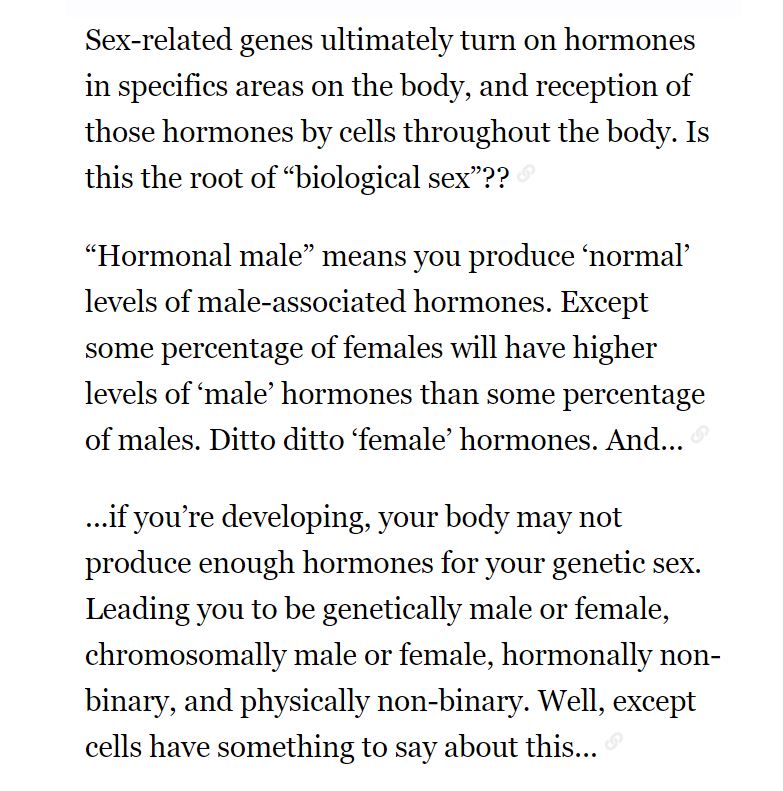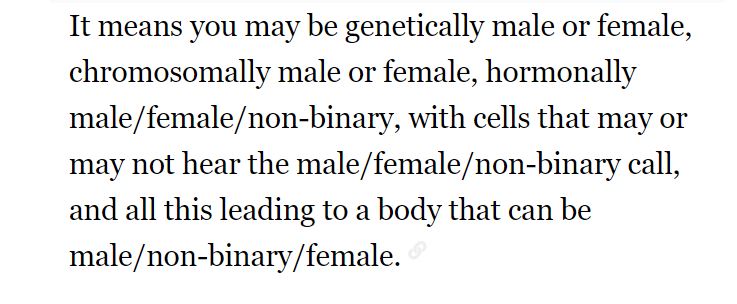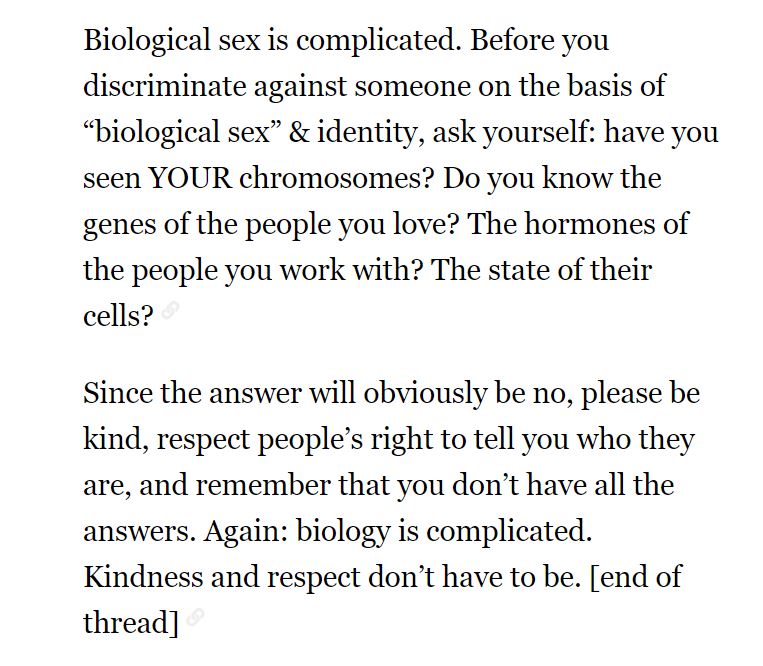1/ In December 2019, a marine biologist (Helm) wrote a thread about how biological sex can have more complex combinations than male or female. We call this the & #39;sex spectrum.& #39;
Let& #39;s explore it with peer-reviewed science. https://archive.is/UpgQB ">https://archive.is/UpgQB&quo...
Let& #39;s explore it with peer-reviewed science. https://archive.is/UpgQB ">https://archive.is/UpgQB&quo...
2/ Proponents of the sex spectrum recognize that there is a diverse range of anatomy and physiology within males and females that often overlaps.
Knowing this, they reason that perhaps the dividing line between male and female is determined by society, rather than biology.
Knowing this, they reason that perhaps the dividing line between male and female is determined by society, rather than biology.
3/ If the dividing line between male and female is arbitrary, they argue, then classifying individuals as male and female should lose its social significance.
This & #39;sociological premise& #39; is the core of the sex spectrum argument, not the biology it presents on the surface.
This & #39;sociological premise& #39; is the core of the sex spectrum argument, not the biology it presents on the surface.
4/ This sociological premise--that male and female should have no social significance--is the underlying argument of Helm& #39;s thread.
Even though most of the thread seems like it& #39;s about biology, the biology is only used as a rhetorical tool to reinforce the sociological premise.
Even though most of the thread seems like it& #39;s about biology, the biology is only used as a rhetorical tool to reinforce the sociological premise.
5/ So how is this idea--that male and female are arbitrary--reinforced?
The answer is through showing that individuals cannot always be divided into male or female through *one single trait.*
And this is where we begin with Helm& #39;s thread.
The answer is through showing that individuals cannot always be divided into male or female through *one single trait.*
And this is where we begin with Helm& #39;s thread.
6/ Helm looks at the atypical combinations of chromosomes, hormones, and cells to show that there is no single trait we can call "biological sex."
I& #39;ll include screenshots of her thread as we go along. We& #39;ll start with chromosomes.
I& #39;ll include screenshots of her thread as we go along. We& #39;ll start with chromosomes.
7/ CHROMOSOMES: It& #39;s true that XX and XY do not always mean you will develop as a female or male, respectively.
For example, Helm rightfully points out that a translocation of the SRY gene to an X chromosome can cause XX individuals to develop as males.[1][2][3]
For example, Helm rightfully points out that a translocation of the SRY gene to an X chromosome can cause XX individuals to develop as males.[1][2][3]
8/ On the other hand, if the SRY gene is absent in an XY zygote and/or the gonads do not differentiate into testes, these individuals will develop as females with Mullerian reproductive structures.[4]
9/ DSD XX males and XY females are not in between sexes or new sexes. They are unambiguously male and female. How?
Because male and female are not defined through chromosomes, but rather, through the reproductive anatomies they develop for the production of sperm or ova.[5][6]
Because male and female are not defined through chromosomes, but rather, through the reproductive anatomies they develop for the production of sperm or ova.[5][6]
10/ XX males develop reproductive anatomies structured for sperm, even if they are infertile, and XY females develop reproductive anatomies structured for ova, even if they are infertile as well.
And this, the reproductive phenotype, is the marker of sex.
And this, the reproductive phenotype, is the marker of sex.
11/ HORMONES: It& #39;s true that hormone levels are variable within males and females and between them. This means there& #39;s a distribution for males and a distribution for females with different amounts of overlap depending on the hormone. But hormonal profiles do not define sex.
12/ For example, females with Congenital Adrenal Hyperplasia are often exposed to male-typical levels of androgens in the womb, sometimes virilizing (masculinizing) the external genitalia.[7] And males with Klinefelter& #39;s (47,XXY) can often experience low testosterone levels.[8]
13/ Both males with 47,XXY and females with CAH are defined as male and female, respectively, despite their hormone levels. How? Because male and female are not defined through hormone levels but through the reproductive anatomies they develop for the production of sperm or ova.
14/ CELLS: Cells have protein molecules known as receptors which bind to hormones. Some receptors code for sex hormones like estrogen and testosterone. If the receptor has a mutation, the sex hormone might not be able to bind to the receptor, and the signal will not be sent.
15/ For example, if the gene which codes for androgen receptors has a mutation, testosterone in an XY fetus will not be able to bind to androgen receptors to build masculinized structures, and the fetus will develop a female phenotype, as in cases of CAIS.[9]
16/ THE PREMISE: For proponents of the sex spectrum, all this variation in sex development means we can define your sex through chromosomes, or hormones, or through cells, and this can all be combined in different ways, creating a spectrum of sex.
17/ Because it seems like biological sex cannot be defined through one singular trait, Helm makes an interesting case that perhaps male and female are not as cleanly defined as we think, and this is where the sociological premise of her argument is revealed.
18/ The sociological premise is that, if we cannot clearly define male and female, we should not use & #39;biological sex& #39; as a socially significant category, and thus, we should allow identity--one& #39;s internal sense of self--to be the primary marker for the ordering of society.
19/ The problem, however, is that Helm shows the diversity of sex development mechanisms that produces males and females while never defining the terms & #39;male& #39; and & #39;female.& #39;
Variations in sex development do exist, but these variations still form males and females, not new sexes.
Variations in sex development do exist, but these variations still form males and females, not new sexes.
20/ Despite the diversity of sex development mechanisms and the wide variety of secondary sex characteristics in humans and other animals, male and female are not arbitrarily divided but can be objectively defined across all sexually reproducing species.
Here& #39;s how. https://abs.twimg.com/emoji/v2/... draggable="false" alt="👇" title="Rückhand Zeigefinger nach unten" aria-label="Emoji: Rückhand Zeigefinger nach unten">
https://abs.twimg.com/emoji/v2/... draggable="false" alt="👇" title="Rückhand Zeigefinger nach unten" aria-label="Emoji: Rückhand Zeigefinger nach unten">
Here& #39;s how.
21/ If one develops a phenotype structured for small gametes, one is male, and if one develops a phenotype structured for large gametes, one is female.[10]
Gamete type is the ultimate dividing line of sex, and phenotype (reproductive anatomy) functions as the marker.[11]
Gamete type is the ultimate dividing line of sex, and phenotype (reproductive anatomy) functions as the marker.[11]
22/ One& #39;s reproductive anatomy does not have to be fully developed or fully functional to be a male or female. All the classification needs is that you started on the path of development towards the production of sperm or ova, regardless of past, present, or future functionality.
23/ As Helm writes, we should not use sex, or other biological criteria, to discriminate against someone based on their identity. Everyone should be treated with respect.
At the same time, biological sex is real and important, and bigoted beliefs do not define scientific facts.
At the same time, biological sex is real and important, and bigoted beliefs do not define scientific facts.
24 END / Biological sex, male and female, is one of the most objective categories in biology, clearly definable across all sexually reproducing species, and it& #39;s why we are all here in the first place.
We don& #39;t have to deconstruct its meaning to treat others with respect.
We don& #39;t have to deconstruct its meaning to treat others with respect.
Evolutionary biologist Dr. Heather Haying responds to the & #39;sex spectrum& #39; https://twitter.com/HeatherEHeying/status/1211868947227660288?s=20">https://twitter.com/HeatherEH...
Developmental biologist Dr. Emma Hilton explains how we define sex. https://twitter.com/FondOfBeetles/status/1195323397041000448?s=20">https://twitter.com/FondOfBee...
Why Sex Is Binary https://www.youtube.com/watch?v=XN2-YEgUMg0">https://www.youtube.com/watch...
Here& #39;s 9 reasons why sex is important https://www.youtube.com/watch?v=k8iOKd9KIMk&ab_channel=ParadoxInstitute">https://www.youtube.com/watch...
Sources:
[1] Kimball, J. (2020). Sex chromosomes. http://LibreText.org"> http://LibreText.org
[2] Kashimada, K., Koopman, P. (2010). Sry, the master switch in mammalian sex determination. Development, 137.
[1] Kimball, J. (2020). Sex chromosomes. http://LibreText.org"> http://LibreText.org
[2] Kashimada, K., Koopman, P. (2010). Sry, the master switch in mammalian sex determination. Development, 137.
[3] Gilbert, SF. (2000). Chromosomal sex determination in mammals. Developmental Biology, 6th edition. Sunderland (MA), Sinauer Associates.
[4] NIH. (2020). Swyer syndrome. Genetics Home Reference, National Institutes of Health.
[4] NIH. (2020). Swyer syndrome. Genetics Home Reference, National Institutes of Health.
[5] Kumar et al. (2019). Anisogamy. Encyclopedia of Animal Cognition and Behavior.
[6] Lehtonen, J., Parker, G. (2014). Gamete competition, gamete limitation, and the evolution of two sexes. Molecular Human Reproduction, 20(12).
[6] Lehtonen, J., Parker, G. (2014). Gamete competition, gamete limitation, and the evolution of two sexes. Molecular Human Reproduction, 20(12).
[7] NIH. (2020). 21-hydroxylase deficiency. Genetics Home Reference, National Institutes of Health.
[8] NIH. (2020). Klinefelter syndrome. Genetics Home Reference, National Institutes of Health.
[8] NIH. (2020). Klinefelter syndrome. Genetics Home Reference, National Institutes of Health.
[9] NIH. (2020). Androgen insensitivity syndrome. Genetics Home Reference, National Institutes of Health.
[10] Lehtonen, J. (2017). Gamete Size. Encyclopedia of Evolutionary Psychological Science.
[10] Lehtonen, J. (2017). Gamete Size. Encyclopedia of Evolutionary Psychological Science.
[11] Cox, P., Togashi, T. (2011). The Evolution of Anisogamy, A Fundamental Phenomenon Underlying Sexual Selection. New York Cambridge University Press.
[12] Hilton, E. (2019). Karyotype studies show 99.99% concordance of sex chromosomes with external genitalia. Twitter.
[12] Hilton, E. (2019). Karyotype studies show 99.99% concordance of sex chromosomes with external genitalia. Twitter.
@threader_app compile

 Read on Twitter
Read on Twitter![7/ CHROMOSOMES: It& #39;s true that XX and XY do not always mean you will develop as a female or male, respectively. For example, Helm rightfully points out that a translocation of the SRY gene to an X chromosome can cause XX individuals to develop as males.[1][2][3] 7/ CHROMOSOMES: It& #39;s true that XX and XY do not always mean you will develop as a female or male, respectively. For example, Helm rightfully points out that a translocation of the SRY gene to an X chromosome can cause XX individuals to develop as males.[1][2][3]](https://pbs.twimg.com/media/Ejb7S0hWkAMhxsD.jpg)
![7/ CHROMOSOMES: It& #39;s true that XX and XY do not always mean you will develop as a female or male, respectively. For example, Helm rightfully points out that a translocation of the SRY gene to an X chromosome can cause XX individuals to develop as males.[1][2][3] 7/ CHROMOSOMES: It& #39;s true that XX and XY do not always mean you will develop as a female or male, respectively. For example, Helm rightfully points out that a translocation of the SRY gene to an X chromosome can cause XX individuals to develop as males.[1][2][3]](https://pbs.twimg.com/media/Ejb7bF5XgAEvMgs.jpg)
![8/ On the other hand, if the SRY gene is absent in an XY zygote and/or the gonads do not differentiate into testes, these individuals will develop as females with Mullerian reproductive structures.[4] 8/ On the other hand, if the SRY gene is absent in an XY zygote and/or the gonads do not differentiate into testes, these individuals will develop as females with Mullerian reproductive structures.[4]](https://pbs.twimg.com/media/Ejb7cveXsAEcgAz.jpg)

![15/ For example, if the gene which codes for androgen receptors has a mutation, testosterone in an XY fetus will not be able to bind to androgen receptors to build masculinized structures, and the fetus will develop a female phenotype, as in cases of CAIS.[9] 15/ For example, if the gene which codes for androgen receptors has a mutation, testosterone in an XY fetus will not be able to bind to androgen receptors to build masculinized structures, and the fetus will develop a female phenotype, as in cases of CAIS.[9]](https://pbs.twimg.com/media/Ejb745uXcAAf7JB.jpg)




